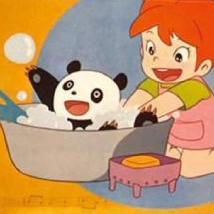The Vampire Doll
She was caught in a landslide and had no escape from reality!

Japanese poster | Toho
1970 — Japan — Yuureiyashiki no kyoufu: Chi wo suru ningyou
A TOHO production
Cast: KAYO MATSUO, AKIRA NAKAO, YUKIKO KOBAYASHI, YOKO MINAMIKAZE, ATSUO NAKAMURA, KAKU TAKASHINA and JUNYA USAMI
Director: MICHIO YAMAMOTO
Producers: TOMOYUKI TANAKA and FUMIO TANAKA
Screenplay: EI OGAWA and HIROSHI NAGANO
Editor: KOUICHI IWASHITA
Cinematography: KAZUTAMI HARA
Art design: YOSHIFUMI HONDA
Music: RIICHIROU MANABE
© Toho Co. Ltd
The ‘70s were like a weird transitional period in Japanese cinema. Actually, it was a kind of a weird transitional period in a lot of countries’ cinema, but we’re talking about Japan’s today! The basic reason is much the same as in Europe, mind you. Television had proliferated the nation to an extent where box office takings were down generally, and at the cinemas themselves films by the Hollywood studios had a level of gloss that the local industry could usually only dream of on their budgets, and which with the demise of the Hays Code in the late ‘60s were no longer bound to abide by the morals of the most puritanical segments of America. This rather introduced a need for a rethink by the local studios as to how to get arses in seats for their own damn films, thereby, one assumes, getting more tasty profits. True to form, the big cinema chains were owned by the studios (hell, some still are) but why settle for x amount of pie, when you could have >x amount of pie or whatever? So, yeah, where I’m headed with this is that Toho made some fake Hammer films, starting with this one here, to try and combat these doldrums.
In actuality, despite the ‘fake Hammer’ label I just applied; which really isn’t just on me, it’s like a whole thing, and as far as I can tell even the producer, Fumio Tanaka, for whom this line of films was brainchild mentioned openly aiming for something akin to Hammer’s Dracula films; this one at least feels less like a Hammer film and more in the vein of Roger Corman’s Poe films with some I Walked With a Zombie (1943) mixed in. Said producer did apparently state Poe’s ‘The Facts in the Case of M. Valdemar’ (1845) as being a major influence on the story, which might explain some of this.†
Kazuhiko Sagawa (Atsuo Nakamura) has returned home from America and nigh immediately sets forth to the countryside to visit his fiancée, the beautiful Yuko Nonomura (Yukiko Kobayashi), at her mother’s big isolated western-style manor (the explanation for why they have a spooky Gothic house is that her late husband was a foreign ambassador and got used to that kind of crap before returning to Japan, enough to get one of his own). Wouldn’t you know it though, the mater (Yoko Minazake) says that she’s dead. Quite freshly at that, having been killed in an automobile accident during a huge storm… JUST LIKE TONIGHT! He loiters around anyway, being all full of denial and also somewhat distracted by the faint sobs that seem to be coming from her locked bedroom. Deigning to sneak a peek, it appears most certain that a woman is in there, but blink and you miss her apparently, or you get knocked unconscious. One of the two. Coming round, he spies the alleged Yuko prancing around outside in a floaty diaphanous gown, as is the style in this sort of film, and goes off after her only to find her grave. Fortunately, she’s not too far behind! A week later, his sister, Keiko (Kayo Matsuo), is rather worried about his whereabouts, given as he hasn’t had any contact with anyone during this time. Her dickhead boyfriend, Hiroshi (Akira Nakao), is openly dismissive of her concerns, but she manages to get him to drive her off to the Nonomura house to inquire after him anyway.
At a tight 71 minutes, this moves along even more briskly than the films that ostensibly inspired it. There’s not a whole lot of time to beat around the bush, and so Keiko tends to be pretty savvy at figuring out when something’s amiss, possibly more than she should be as the film does occasionally manage to just gloss over entirely reasonable possibilities for apparently sinister dealings (I mean, they are sinister obviously, but the evidence conclusions are drawn from often seem a bit circumstantial) and red herrings. You do get her boyfriend gaslighting her though, even if he seems perfectly willing to jump to the same sort of conclusions himself when someone other than her brings stuff up… so long as they’re a man. Have I mentioned he’s a total dickhead? Seriously, it seems like the film doesn’t really realise how much of a dickhead he is. There is literally a scene where Yuko’s mother dumps a load of exposition on him as to her whole deal is only for him to immediately ask what her motivation was even though it was covered pretty extensively in her big speech. It half makes one think his awfulness is intentional, though it feels rather unlikely in context.
The film is built rather inherently around the Old Dark House element, and rather than being a straight horror film, it plays out more like an old timey mystery movie where there’s like a fake psychic or something (good god, fake supernatural phenomena was a common plot motif for a while there) except it turns out that the preternatural element is real rather than some Scooby-Doo style gubbins to hide a murder or smuggling ring or whatever. I suppose I’ve kind of spoiled part of the nature of the reveal with those earlier points of comparison, but the gradual shift to straighter material is quite well done. Trying to avoid going into too much detail, but, as you may have figured out, despite the (English) title,‡ vampirism isn’t really a part of what’s afoot. There are some lines where characters suggest haemophagy on the part of who or what is stalking the house and its grounds, but it never really seems apparent that people and animals and that are being killed with the intent of consuming their blood rather than general maniacality. Similarly, the cast is too small and the setting too limited to really pull off its explanation of the motive behind the murders. The thing’s relatively tight budget presumably being the key factor here, it somehow works despite itself. Indeed, its limitations kind of gel with its idiosyncratic setting. Its amalgamation of western and eastern horror tropes and its very late-‘60s/early-‘70s Japanese stylisation provide a sort of oneiric feeling that makes it easier to gloss over the more cumbersome elements of its plotting.
Seriously though, Keiko could do better.
† In case you’re wondering, yes, Corman did this one, though not as its own film. It’s instead one of the stories in the anthology film Tales of Terror (1962).
‡ The ‘Chi o Suru’ that appears in the Japanese titles of each of the three films and is used (in Japanese) to denote the series is generally rendered in English as ‘Bloodthirsty’. It might be more literally taken as ‘Bloodsucking’, so in that sense this one’s official English title (well, one of them) 'The Vampire Doll’ is, I guess, a valid enough interpretation even if it does seem a tad misleading. The alternative English title that also gets used is ‘Legacy of Dracula’ which ties it in with the other two films, whose official English titles both follow a ‘[blank]
of Dracula’ format, but manages to be more misleading still as our good friend Dracula doesn’t feature here at all… or apparently in either of the two more overtly vampire-y films. The most recent official translation (at least) hedges its bets and uses both in subtitling the title card, as you might notice on the trailer up there. The Japanese supertitle (or whatever you want to call what is essentially a subtitle but in front of the main title) equates to something like ‘Horror of the Haunted House’, by the way.
At time of writing, The Vampire Doll is available to stream on Arrow Player (and on Amazon if you're subscribed to the Arrow service). It's also available to rent off of Amazon and Youtube, amongst other services. I recommend JustWatch for keeping up with where films are streaming (including this one!). Alternatively, physical copies are reportedly available for rent via Cinema Paradiso; note however that the DVD and Blu-Ray releases are, at time of writing, listed separately, with the latter only available as part of two disc collection of the three films which is reflected in the listing (it's on the first disc).
The film presently has a 15 rating, but its last submission to the BBFC (circa 2003) predates them putting detailed into on their website so again I'm going to have to try and determine why myself… well, it gets surprisingly bloody, more so than a lot of Hammer or AIP films of the era, and there are references to sexual violence.



